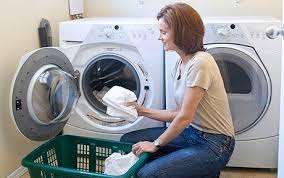GCSE Standard Questions: Electricity in the Home
A1. A washing machine has an electric motor and an electric heater.

The resistance of the heater is 22 Ω. The mains voltage is 230 V.
(a)
(i) State the equation linking voltage, current and resistance.
voltage = current x resistance OR V = IR
(1 mark)
(ii) Show that the current in the heater is about 10 A when it is working.
You must show the stages of your working - you are asked to SHOW this is true!
V = IR
so, R = V/I 
R = 230 / 22
= 10.45 A 
This rounds to 10 A.
(2 marks)
(b) The washing machine is fitted with a fuse rated at 13 A.
(i) Explain why the washing machine is fitted with a fuse.
The fuse is a safety device. 
In case of fault with the appliance (such as a short circuit ) excessive current
) excessive current  (more than 13A) could flow through the device. The fuse would then 'blow' and reduce the risk of the appliance overheating
(more than 13A) could flow through the device. The fuse would then 'blow' and reduce the risk of the appliance overheating . This overheating could cause damage to components such as microprocessor chips within the circuitry or even cause a fire.
. This overheating could cause damage to components such as microprocessor chips within the circuitry or even cause a fire.
A fuse reduces the danger of electrocution  to the user when used in conjunction with earthing cicuitry.
to the user when used in conjunction with earthing cicuitry.
(2 marks maximum)
(ii) When the motor is working, the current in it is 1.74 A. Explain why it would not be sensible to replace the 13 A fuse with a 2 A fuse.
Because the total current (in motor and heater) would be more than 2A (it would be 10A) when the machine was operating.
A 2A fuse would therefore 'blow' (melt), breaking the circuit and preventing the machine from operating at all.
(2 marks)
(Total 7 marks)





